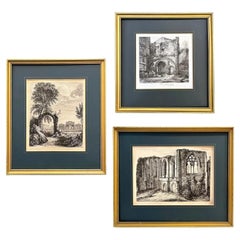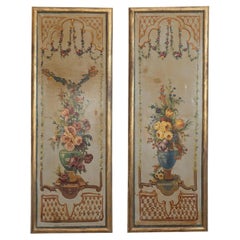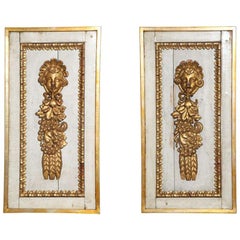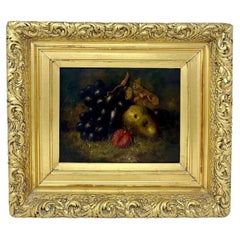Giltwood Decorative Art
Early 19th Century British Georgian Antique Giltwood Decorative Art
Glass, Wood, Giltwood, Paper
1830s French Louis Philippe Antique Giltwood Decorative Art
Metal
Mid-19th Century French Napoleon III Antique Giltwood Decorative Art
Canvas, Giltwood
19th Century French Neoclassical Antique Giltwood Decorative Art
Wood, Giltwood
20th Century Irish Victorian Giltwood Decorative Art
Canvas, Giltwood
Early 19th Century English Victorian Antique Giltwood Decorative Art
Canvas, Giltwood
Late 19th Century French Art Deco Antique Giltwood Decorative Art
Canvas, Giltwood, Paint
Early 20th Century French Giltwood Decorative Art
Canvas, Giltwood, Paint
Late 18th Century French Louis XVI Antique Giltwood Decorative Art
Metal
Late 19th Century French Antique Giltwood Decorative Art
Canvas, Giltwood
Late 19th Century Italian Neoclassical Antique Giltwood Decorative Art
Giltwood
Mid-20th Century French Empire Giltwood Decorative Art
Wood, Paint, Paper, Giltwood
Early 20th Century English Victorian Giltwood Decorative Art
Giltwood, Paint
Late 18th Century French Louis XVI Antique Giltwood Decorative Art
Giltwood
1790s French Louis XVI Antique Giltwood Decorative Art
Giltwood
1910s Italian Baroque Vintage Giltwood Decorative Art
Canvas, Giltwood
18th Century American Other Antique Giltwood Decorative Art
Glass, Giltwood, Paper
19th Century Dutch Dutch Colonial Antique Giltwood Decorative Art
Mother-of-Pearl, Glass, Giltwood, Paint
1910s Italian Baroque Vintage Giltwood Decorative Art
Canvas, Giltwood
Late 19th Century Italian Baroque Antique Giltwood Decorative Art
Canvas, Giltwood
1940s American Neoclassical Vintage Giltwood Decorative Art
Porcelain, Giltwood
21st Century and Contemporary Vietnamese Anglo-Japanese Giltwood Decorative Art
Wood, Giltwood
Early 19th Century French Louis XV Antique Giltwood Decorative Art
Canvas, Giltwood
19th Century German Neoclassical Revival Antique Giltwood Decorative Art
Giltwood, Canvas
Late 18th Century English Tudor Antique Giltwood Decorative Art
Silk, Thread, Glass, Giltwood
Late 18th Century English George III Antique Giltwood Decorative Art
Giltwood
18th Century Italian Baroque Antique Giltwood Decorative Art
Canvas, Giltwood
17th Century French Baroque Antique Giltwood Decorative Art
Canvas, Giltwood
18th Century and Earlier Italian Renaissance Antique Giltwood Decorative Art
Gold Leaf
1980s American Other Vintage Giltwood Decorative Art
Canvas, Giltwood
19th Century French Antique Giltwood Decorative Art
Canvas, Giltwood
Mid-19th Century French Empire Antique Giltwood Decorative Art
Glass, Wood, Giltwood, Paper
17th Century Italian Renaissance Antique Giltwood Decorative Art
Gesso, Canvas, Giltwood
Early 20th Century Austrian Giltwood Decorative Art
Canvas, Giltwood, Wood, Paint
Late 19th Century British Late Victorian Antique Giltwood Decorative Art
Metal
19th Century English Antique Giltwood Decorative Art
Wool, Giltwood
Early 2000s Giltwood Decorative Art
Wood, Giltwood
Late 19th Century French Antique Giltwood Decorative Art
Canvas, Giltwood
Early 20th Century Swiss Islamic Giltwood Decorative Art
Giltwood, Canvas
1890s English Late Victorian Antique Giltwood Decorative Art
Canvas, Wood, Giltwood
19th Century French Renaissance Revival Antique Giltwood Decorative Art
Giltwood, Canvas
20th Century French Giltwood Decorative Art
Silk, Giltwood
1830s French Charles X Antique Giltwood Decorative Art
Giltwood
19th Century Victorian Antique Giltwood Decorative Art
Lava
Mid-18th Century Italian Baroque Antique Giltwood Decorative Art
Gesso, Giltwood, Wood
17th Century Peruvian Antique Giltwood Decorative Art
Wood, Paint, Giltwood
19th Century German Belle Époque Antique Giltwood Decorative Art
Canvas, Upholstery, Giltwood, Paint
Late 19th Century Russian Baroque Antique Giltwood Decorative Art
Gesso, Canvas, Giltwood, Paint
Early 19th Century French Empire Antique Giltwood Decorative Art
Giltwood, Paint
Early 19th Century French Neoclassical Antique Giltwood Decorative Art
Glass, Giltwood
Early 19th Century American Regency Antique Giltwood Decorative Art
Giltwood, Paper
Early 20th Century British Victorian Giltwood Decorative Art
Giltwood, Birdseye Maple, Maple
Mid-19th Century Italian Renaissance Revival Antique Giltwood Decorative Art
Wood, Giltwood
Late 18th Century Swedish Gustavian Antique Giltwood Decorative Art
Mirror, Pine, Giltwood
19th Century Chinese Chinese Export Antique Giltwood Decorative Art
Silk, Giltwood
Early 20th Century French Empire Giltwood Decorative Art
Canvas, Giltwood
Late 18th Century French Chinoiserie Antique Giltwood Decorative Art
Canvas, Giltwood
Early 19th Century Italian Grand Tour Antique Giltwood Decorative Art
Bronze
19th Century French Rococo Revival Antique Giltwood Decorative Art
Canvas, Giltwood
Late 18th Century French Empire Antique Giltwood Decorative Art
Mirror, Giltwood, Pine
Read More
At Colonial Williamsburg, Everything Old Is New Again
With the help of a new director, the Virginia institution's folk art and decorative arts museums are undergoing extensive upgrades.
New York’s Hirschl & Adler Showcases the American Workmanship and Design Panache of Neoclassical Treasures
The gallery's latest exhibition proves that museum-quality pieces entice and inspire, whether in traditional or more modern interiors.





